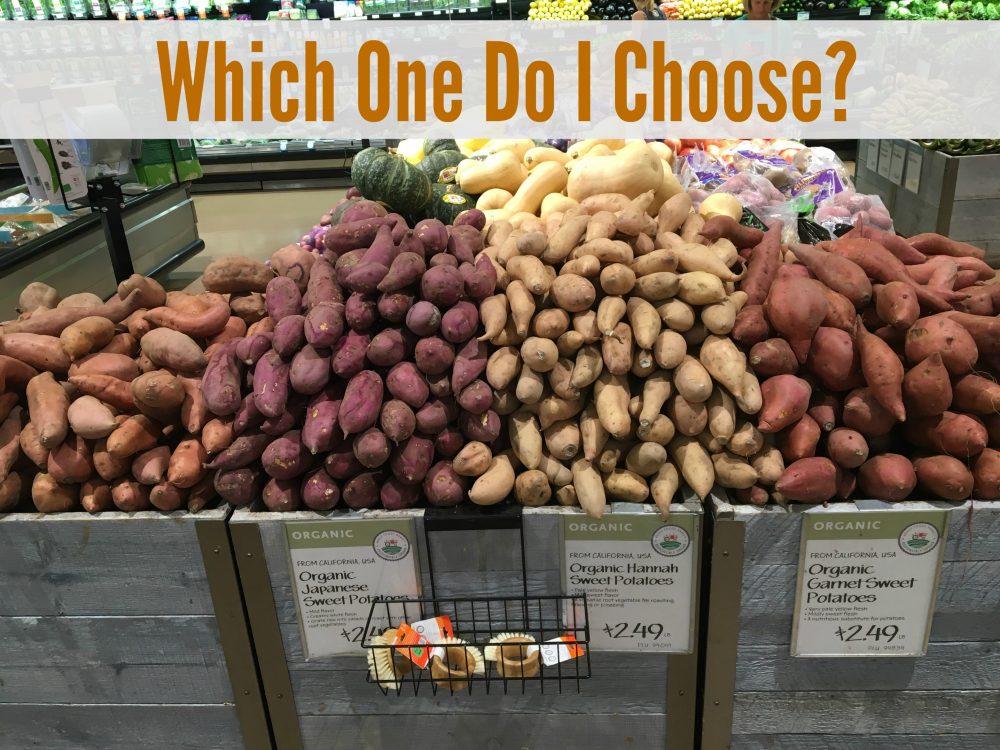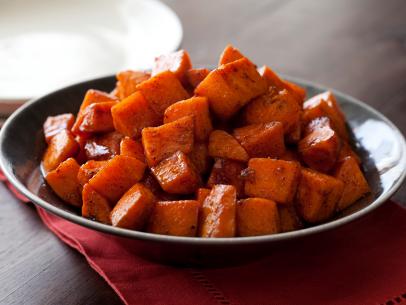Posted by Linda | October 9, 2016
Which One Do I Choose?

Have you walked up to the sweet potatoes in the produce section and wondered “What is the difference between them and which one is better for me?” Well, let me help you understand the difference so the next time you go, you are informed.
Sweet potatoes are nutritionally very different than regular potatoes. Sweet potatoes are rich in beta-carotene, which is the same antioxidant nutrient that is found in carrots. You might remember this from one of my previous blog posts on carrots. The benefits of sweet potatoes include but are not limited being an excellent source of Vitamin A, an antioxidant food, anti-inflammatory protection and potentially improve in blood sugar regulation.
In the picture above we can see that there are several colors of sweet potatoes but, the color of their insides is more telling than the color of their outsides.
Japanese Sweet Potato
Japanese Sweet potatoes have purple skin and white-colored flesh.
Hannah Sweet Potato
Hannah sweet potatoes have cream skin and white-colored flesh.
Garment Sweet Potato
Garment sweet potatoes have reddish colored skin and orange-colored flesh.
Jewel Sweet Potato
Jewel sweet potatoes have orange colored skin and deep orange flesh.
Orange/Yellow Fleshed
The intensity of the color of orange and yellow fleshed sweet potatoes (Garment and Jewel) is directly correlated to its beta-carotene content, which produces vitamin A. It is often referred to as provitamin A. Jewel sweet potatoes are mildly sweet and fairly firm on the inside when cooked. Garment potatoes are mildly sweet and moist on the inside when cooked.
White/Cream Fleshed
White and cream fleshed potatoes (Hannah and Japanese) have less provitamin A, but they are still good for you! Hannah sweet potatoes are firm and dry when cooked. Japanese potatoes are sweet and fairly firm on the inside when cooked.
Nutritional Profile
One medium sweet potato has 180 calories with 4 g of protein, 41 g of carbohydrates, 6 g of fiber and .30 g of fat.
Tips
- Select a sweet potato that is firm and is free of any cracks, bruises or soft spots. If possible, purchase organic sweet potatoes.
- Store sweet potatoes outside of the refrigerator in a cool, dry, and dark place.
- If you buy conventionally grown sweet potatoes, make sure to peel them before consumption.
- To prevent them from changing color after you peel and cut them, place them in water a bit of lemon juice.
- The best way to cook sweet potatoes is to steam them.
- Including some fat in your sweet potatoes (like ghee or grass fed butter) as this helps to get the full beta-carotene benefit of this root vegetable.
Recipe
Roasted Sweet Potatoes with Honey and Cinnamon

Adapted from The Food Network
Prep time: 15 minutes
Cook time: 30 minutes
4 servings
Ingredients
- Four sweet potatoes, peeled and cut into 1-inch cubes
- 1/4 cup extra-virgin olive oil, plus more for drizzling potatoes after cooked
- 1/4 cup honey
- Two teaspoons ground cinnamon
- Salt and freshly ground black pepper
Directions
- Preheat oven to 375 degrees F.
- Lay the sweet potatoes out in a single layer on a roasting tray.
- Drizzle the oil, honey, cinnamon, salt and pepper over the potatoes.
- Roast for 25 to 30 minutes in an oven or until tender.
- Take sweet potatoes out of the oven and transfer them to a serving platter.
- Drizzle with more extra-virgin olive oil.
Just a reminder that the Getting Back On Track Fall Program is starting on October 17th. You can find more information and sign up for the program here.
References:
http://paleomagazine.com/types-of-sweet-potatoes-with-images-and-why-you-should-eat-them
The World’s Healthiest Foods by George Mateljan
